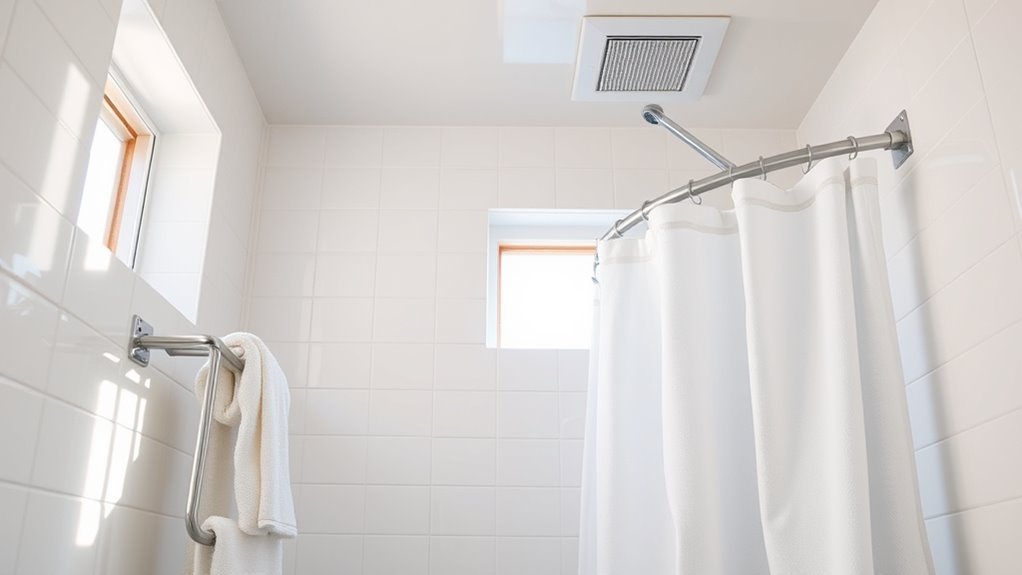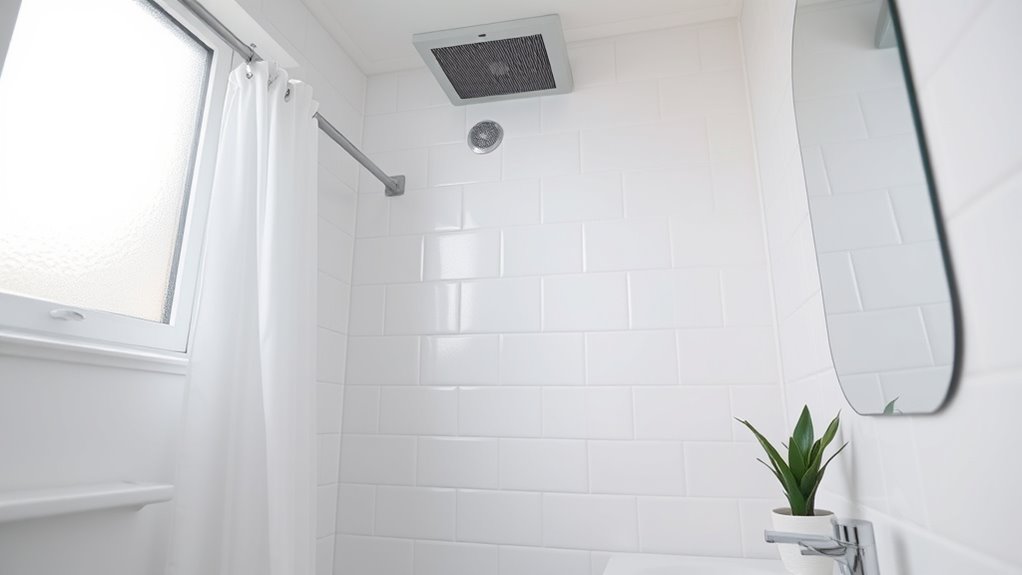To prevent bathroom mold and mildew, make sure your bathroom stays dry and well-ventilated. Use exhaust fans during and after showers, open windows if possible, and run a dehumidifier if needed. Regularly wipe down surfaces, clean grout and corners, and dry damp areas with towels or squeegees. Keep mold-spreading surfaces clean, inspect for issues regularly, and stay consistent with these practices. Continuing to implement these tips will help keep your bathroom mold-free and fresh.
Key Takeaways
- Ensure proper ventilation by using exhaust fans during and after showers, or open windows to reduce moisture buildup.
- Regularly clean bathroom surfaces, grout, and corners with mold-inhibiting solutions to eliminate mold spores.
- Dry surfaces like glass doors and tiles after use to prevent water absorption and mold growth.
- Inspect and maintain ventilation systems and filters for optimal airflow and moisture control.
- Minimize bathroom clutter and promptly address any signs of mold or mildew to prevent spreading.

Mold and mildew thrive in damp, poorly ventilated bathrooms, making prevention essential for maintaining a healthy space. If you want to keep these fungi at bay, focusing on proper ventilation techniques is vital. Installing an exhaust fan or ensuring existing fans work efficiently helps remove excess moisture from the air. Keep the fan running during and after showers, ideally for at least 20 minutes, to dry out the space thoroughly. If your bathroom lacks an exhaust fan, consider opening windows or using a portable dehumidifier to reduce humidity levels. Maintaining ideal airflow prevents moisture from settling on surfaces and creating the perfect environment for mold growth.
Alongside ventilation techniques, establishing a consistent cleaning schedule is key to preventing mold and mildew buildup. Regularly wiping down surfaces like shower walls, doors, and sinks minimizes the chance for mold spores to take hold. Pay special attention to grout lines, caulking, and corners where water tends to accumulate. Use mold-inhibiting cleaning agents or a mixture of vinegar and water to disinfect these areas weekly. Scrubbing grout lines with a toothbrush helps remove soap scum and dirt, which can serve as food sources for mold. Don’t forget to clean your bathroom fan filter periodically—blocked filters reduce airflow, making ventilation less effective.
Regularly clean surfaces and fan filters to prevent mold buildup and ensure effective ventilation.
In addition to routine cleaning, drying surfaces after use greatly reduces moisture levels. Use a squeegee on glass doors and tiles or dry them with a towel to eliminate lingering dampness. This simple habit prevents water from seeping into porous materials like grout or drywall, where mold can settle and grow unnoticed. Keep bathroom clutter minimal, as cluttered spaces trap moisture and hinder airflow. Store towels, bathmats, and other textiles in well-ventilated areas or dryers, not damp corners.
Furthermore, choosing high-quality ventilation systems can significantly improve moisture control and reduce the risk of mold development. Combining good ventilation techniques with a disciplined cleaning schedule creates an environment inhospitable to mold and mildew. Think of your bathroom as a space that requires ongoing maintenance—consistently managing moisture is the most effective way to prevent mold from taking hold. Regularly inspecting for signs of mold or mildew allows you to act promptly before it becomes a bigger problem. By staying vigilant and committed to these practices, you’ll maintain a cleaner, healthier bathroom that resists mold growth and keeps your space fresh and safe.
Frequently Asked Questions
How Often Should I Clean Bathroom Vents to Prevent Mold?
You should clean your bathroom vents at least every six months to prevent mold growth. Regular vent cleaning keeps airflow ideal and reduces humidity buildup, which helps control moisture levels. If your bathroom is particularly humid or you notice mold or musty odors, clean the vents more frequently. Proper humidity control through vent maintenance minimizes condensation and mold spores, protecting your bathroom from mold and mildew issues.
Are There Natural Remedies to Eliminate Existing Mold?
Yes, you can use natural remedies for mold elimination. Vinegar is highly effective; simply spray it on the moldy area and let it sit for an hour before scrubbing. Baking soda mixed with water also works to scrub away mold and deodorize. Tea tree oil, diluted in water, can be sprayed on affected areas for a natural antifungal solution. These remedies are eco-friendly and safe for your home.
Can Mold Spores Affect Indoor Air Quality Long-Term?
Mold spores are like tiny invaders that can silently harm your indoor air quality over time. When these spores linger in your home, they can cause allergies, respiratory issues, and even asthma flare-ups. Long-term exposure to mold spores can deteriorate your indoor air, making it unhealthy to breathe. Keep your environment safe by controlling humidity and ventilating regularly, so mold spores don’t take over your indoor air quality.
What Is the Best Type of Paint to Resist Mold?
The best type of paint to resist mold for your bathroom renovation is mold resistant paint. It contains antimicrobial agents that prevent mold and mildew growth on walls and ceilings. When applying mold resistant paint, guarantee the surfaces are clean and dry for maximum effectiveness. This paint is especially useful in humid areas, helping maintain a healthier indoor environment and prolonging the lifespan of your bathroom’s surfaces.
How Do I Prevent Mold Behind Bathroom Tiles?
To prevent mold behind bathroom tiles, guarantee you seal the grout properly with grout sealing, which blocks moisture from seeping in. Additionally, improve tile ventilation by using an exhaust fan or opening windows during and after showers. Regularly clean the tiles and grout with mold-resistant solutions, and check for any leaks or cracks. These steps help keep moisture out, reducing mold growth behind your tiles effectively.
Conclusion
By staying vigilant and keeping your bathroom dry, you’ll find that mold and mildew become less of a surprise visitor. Sometimes, it’s funny how a simple habit—like wiping down the shower—can prevent bigger issues later. It’s almost like the universe nudges us to take small steps for big results. So, next time you notice a little dampness, remember that a quick fix now can save you from a moldy surprise down the road.









